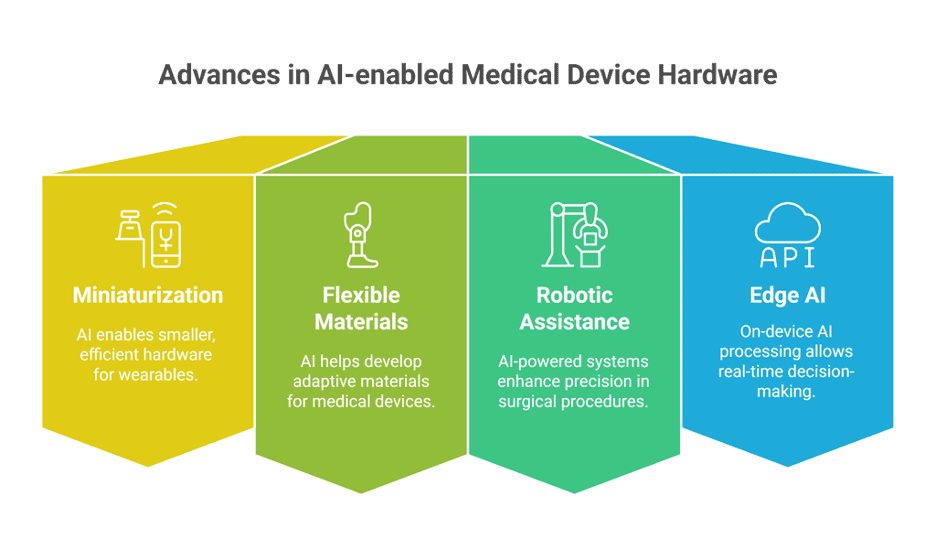In 2024, 107 AI-enabled medical devices received FDA approval, bringing the total number of FDA approved devices to over 950. There’s no question that AI technology is becoming common in medical device development projects, but how are medical device design standards evolving to keep pace?
On January 6, 2025, the FDA released a draft of guidelines to address this new frontier. It establishes clearer design standards, validation protocols, and post-market monitoring requirements for AI-enabled medical devices.
In this article, we’ll discuss why new guidelines are needed for AI-enabled medical devices, the key aspects of the FDA’s draft guidelines, and what manufacturers should do moving forward.
Why AI-Enabled Devices Need New Medical Device Design Standards
AI-enabled medical devices are being developed a bit differently from traditional medical devices, creating new situations and factors that don’t quite align with existing guidelines and regulations. Unlike conventional software that functions based on fixed programming, AI models continuously learn, adapt, and make decisions based on evolving data.
This dynamic nature introduces potential risks for medical devices not addressed in current development guidelines and regulations.
Examples of the new challenges and risks introduced with AI include:
- Algorithm/Model drift. Over time, AI models may shift in ways that affect their accuracy or introduce unintended changes. A diagnostic AI tool that performs well at launch might gradually become less reliable as new patterns emerge in patient data, unless properly managed.
- Data sensitivity & bias. AI models adjust based on the data they receive, but variations in patient demographics, clinical settings, or environmental factors can lead to inconsistent performance and substandard clinical decisions.
- Ongoing validation & monitoring. AI-enabled devices require continuous performance validation to ensure they remain safe and effective across their lifecycle. Without proper monitoring, an AI system’s effectiveness can degrade without detection.
- Regulatory challenges with adaptability. Since AI models evolve, static regulatory approval processes may not be sufficient. A device that updates its algorithm in response to real-world data may need a new regulatory framework to ensure safety without slowing down innovation.

Addressing New Risks: 4 Primary Aspects of the FDA’s Draft Guidance
The FDA’s 2025 draft guidance aims to bridge the gaps that currently exist in regulatory frameworks in AI-enabled medical device design applications.
-
Risk-Based Design Approach for Software
Developers will be required to pay closer attention to a device’s potential risk factors. This includes identifying, assessing, and mitigating risks associated with AI model behavior, such as algorithm drift and data bias. These are safeguards that address non-static software concerns.
For example, safeguards are needed to prevent unintended device performance changes over time, and ensure robust data diversity during model training. These are good options to minimize the risk of using AI technology in a medical device.
-
Total Product Lifecycle (TPLC) Management
The guidance emphasizes a Total Product Lifecycle (TPLC) approach, recognizing that AI-enabled medical devices continuously evolve and require ongoing oversight to remain safe, effective, and compliant.
Rather than treating development as a series of discrete steps, the TPLC framework integrates risk management, validation, and regulatory controls throughout the device’s entire lifespan.
AI-enabled medical devices must be developed with risk and compliance considerations from the outset and then monitored throughout their entire lifecycle to ensure ongoing safety and effectiveness.
- Pre-market development: AI developers must document model training, validation, and testing in regulatory submissions, demonstrating that the device meets safety, efficacy, and performance requirements before entering the market.
- Post-market performance monitoring: Manufacturers must implement continuous monitoring protocols to detect and address performance degradation, algorithm drift, and cybersecurity risks over time.
- Change control plans: To maintain regulatory flexibility without compromising patient safety, manufacturers must establish predefined change control protocols for software updates and modifications, ensuring that AI model adjustments do not require full re-approval unless they significantly alter device performance.
-
Validation and Performance Transparency
As AI-enabled devices evolve over time, they cannot be validated in the same static way as conventional software-driven or mechanical devices.To ensure AI-enabled medical devices remain safe, effective, and unbiased, the FDA will require manufacturers to:
- Document and justify AI model development. This includes providing detailed records of training datasets, methodologies, and bias mitigation strategies to ensure fairness and reliability.
- Validate performance across diverse clinical settings. AI models must undergo real-world testing to demonstrate consistent accuracy and effectiveness across varied patient populations, demographics, and healthcare environments.
- Ensure transparency in AI model performance. Manufacturers must disclose key performance metrics, known limitations, and validation methodologies to regulators, healthcare providers, and end-users, ensuring informed decision-making and accountability.
-
Cybersecurity and Data Integrity
185 million health care records were breached in 2024. Personal Health Information (PHI) is highly valuable to cyber criminals, making medical devices that store, share, and use patient data (such as AI-enabled devices) vulnerable to cybersecurity threats.
These devices are prime targets for cybercriminals, with risks including data poisoning, adversarial attacks, and unauthorized AI model manipulation. To strengthen cybersecurity and data integrity, the FDA’s draft guidance introduces new best practices for AI-enabled medical devices, including:
- Secure data handling protocols. This prevents data poisoning and adversarial manipulation, where malicious inputs corrupt AI models, leading to biased or unsafe outputs.
- Robust encryption and authentication. This ensures AI model updates and patient data transmissions are secure, preventing unauthorized access and model tampering.
- Continuous security monitoring and real-time threat detection. This requires active surveillance for emerging cybersecurity threats, allowing for timely detection and response to vulnerabilities.
| What Does the FDA Draft Mean for AI-Enabled Medical Device Manufacturers?
The FDA’s 2025 draft guidance signals a new era for medical device development standards, where compliance is not a one-time milestone but rather, an ongoing responsibility. It’s time for manufacturers to adapt their development, validation, and post-market strategies to align with these evolving standards. |
Moving Forward: Best Practices for Medical Device Design Standards
-
Build Compliance Into Development from Day One
While intended for AI-enabled developments, addressing compliance as early as possible has benefits for all medical device development projects. Waiting until later stages to address regulatory concerns increases time-to-market and development and costs.
Consider embedding risk management into AI model design to proactively mitigate bias and algorithm drift. Align product development with TPLC principles—considering safety and compliance from ideation to long-term monitoring. Document AI training, validation, and adaptability early to ensure a smoother approval process.
-
Establish Real-Time Monitoring & Change Control Mechanisms
The biggest shift in AI medical device regulation is the requirement for continuous oversight. Say good-bye to the “set-it-and-forget-it” mindset and start viewing devices as dynamic ecosystems in need of ongoing oversight and management.
For AI-devices, consider:
- Implementing automated performance monitoring systems to detect AI drift before it affects patient outcomes.
- Developing change control plans that allow for pre-approved software updates without full re-approval delays.
- Using real-world data feedback loops to refine models while staying within regulatory boundaries.
-
Strengthen Cybersecurity from the Ground Up
AI-enabled devices are prime cybersecurity targets, and compliance now includes robust security measures. Manufacturers should consider cybersecurity measures as early as possible, preventing re-designs midway through the development process and to align compliance needs with device capabilities more harmoniously.
For instance, consider encrypting patient data and AI model updates to prevent unauthorized access. Or, harden AI models against adversarial attacks that could manipulate clinical decision-making. Additionally, adopt proactive cybersecurity monitoring to detect breaches before they compromise patient safety.
-
Foster Transparency & Regulatory Readiness
As AI-enabled medical devices become more sophisticated, the need for transparency will be greater than ever. Manufacturers will soon be required to be proactive in ensuring their AI models remain trustworthy, explainable, and compliant.
With new performance transparency requirements being considered, manufacturers should get behind the following process changes:
- Clearly document AI model decision-making processes for regulators and end-users.
- Educate healthcare providers on AI model limitations and appropriate use cases.
- Prepare for adaptive regulatory frameworks, ensuring that AI-driven updates can be rolled out without regulatory bottlenecks.
AI-Enabled Medical Devices with Vantage MedTech
The FDA’s new draft guidance introduces higher standards for risk management, lifecycle monitoring, and cybersecurity, making it critical for manufacturers to work with a trusted development partner who understands both AI innovation and compliance.
At Vantage MedTech, we are perfectly poised to help AI device developers realize product success. With every expertise needed to ideate, develop, and bring to market under one roof, we bring the holistic approach necessary for successful AI-enabled device development.
Let’s discuss your AI-enabled medical device project and take the next step toward bringing innovative, compliant solutions to market.



